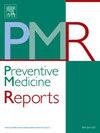Metabolic diseases and lifestyle factors affect arthritis incidence in old Europeans - a cross analysis from the SHARE project
IF 2.4
3区 医学
Q2 PUBLIC, ENVIRONMENTAL & OCCUPATIONAL HEALTH
引用次数: 0
Abstract
Objective
In the context of global aging, the burden of metabolic diseases and arthritis is escalating, necessitating a more comprehensive understanding of the associations between these diseases. As modifiable factor the effect of lifestyle on the progression of arthritis also needs to be considered. Thus, this study aimed to identify the associations of the number of metabolic diseases (MDs) and lifestyle factors, with Rheumatoid Arthritis (RA) and Osteoarthritis (OA).
Methods
This is a cross analysis of data from European cohort collected between 2017 and 2021. The demographic information, lifestyle factors, and disease data were used for a prospective analysis to explore the impact of MDs on the prevalence of arthritis within the 4-year study period (n = 43,085). In addition, a cross-sectional analysis of 9th wave participants (n = 66,208) was conducted to investigate the relationship between lifestyle factors and arthritis. Cox regression and binary logistic regression models were employed to explore the relationships between various factors and arthritis.
Results
About 6.52 % and 12.54 % participants developed RA and OA within the 4-year study period. Individuals with MDs exhibited a higher risk of new-onset arthritis compared to no-MDs participants. OA prevalence was positively associated with higher age, higher BMI, less physical activity (PA) and smoking. RA prevalence was positively associated with higher age, higher BMI and less PA.
Conclusion
There is a causal relationship between the number of MDs and new-onset Rheumatoid Arthritis and Osteoarthritis. Arthritis prevention programs should consider metabolic diseases as well as lifestyle factors in patients at risk.

代谢疾病和生活方式因素影响老年欧洲人关节炎发病率——SHARE项目交叉分析
目的在全球老龄化背景下,代谢性疾病和关节炎的负担不断加重,需要更全面地了解这些疾病之间的关联。作为可改变的因素,生活方式对关节炎进展的影响也需要考虑。因此,本研究旨在确定代谢性疾病(MDs)的数量和生活方式因素与类风湿关节炎(RA)和骨关节炎(OA)的关系。这是对2017年至2021年间收集的欧洲队列数据的交叉分析。采用人口统计信息、生活方式因素和疾病数据进行前瞻性分析,探讨MDs对4年研究期间关节炎患病率的影响(n = 43,085)。此外,对第9波参与者(n = 66,208)进行了横断面分析,以调查生活方式因素与关节炎之间的关系。采用Cox回归和二元logistic回归模型探讨各因素与关节炎的关系。结果在4年的研究期间,分别有6.52%和12.54%的参与者发生RA和OA。与没有MDs的参与者相比,MDs患者出现新发关节炎的风险更高。OA患病率与较高的年龄、较高的BMI、较少的身体活动(PA)和吸烟呈正相关。RA患病率与较高的年龄、较高的BMI和较低的PA呈正相关。结论MDs数量与新发类风湿关节炎和骨关节炎有一定的因果关系。关节炎预防计划应考虑到代谢疾病以及生活方式因素对患者的风险。
本文章由计算机程序翻译,如有差异,请以英文原文为准。
求助全文
约1分钟内获得全文
求助全文
来源期刊

Preventive Medicine Reports
Medicine-Public Health, Environmental and Occupational Health
CiteScore
3.90
自引率
0.00%
发文量
353
 求助内容:
求助内容: 应助结果提醒方式:
应助结果提醒方式:


